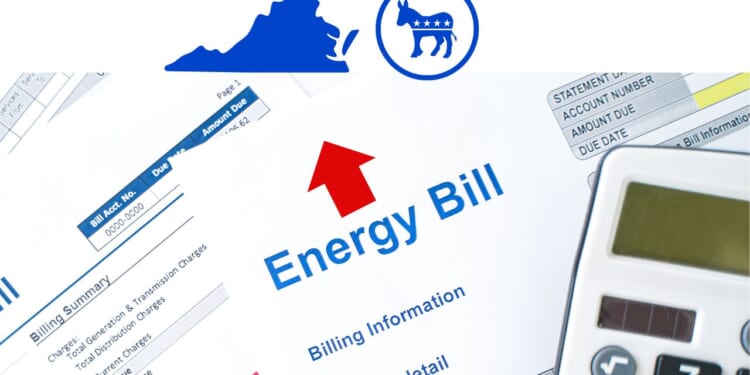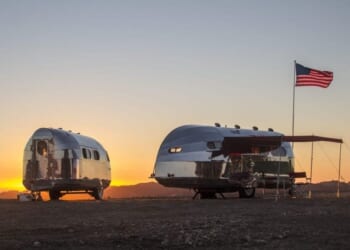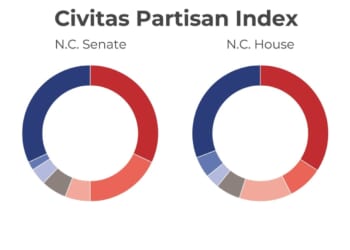Share this Story on Facebook, X, Text, LinkedIn, Gmail, Yahoo Mail, or Outlook
The return of the political trifecta Democrats enjoyed during the 2020 and 2021 General Assembly sessions – now bolstered with a 64-36 majority in the House of Delegates – leaves the question of how to deal with Virginia’s energy issues entirely in their hands.
Only if the Democrats suffer a significant division within their own ranks will the Republican legislators cast votes in committee or on the chamber floor that decide any issue. And with 64 votes in the House (meaning Democrats will also have at least two-thirds of committee seats), it would have to be a deep Democratic split for Republicans to matter.
Most of the new Democratic members including those who ousted sitting incumbent Republicans expressed commitment to the Virginia Clean Economy Act (VCEA) and its goal of ending the use of coal, natural gas and oil. Many in Northern Virginia are also eager to slow down the growth of the data center industry, which is driving up electricity demand across the state.
Incoming Governor Abigail Spanberger has been short on details about efforts to limit data center development and remained vague in this long piece put together by the anti-hydrocarbon advocacy outlet Inside Climate News. As was the case with the pro-solar Clean Virginia rallies described in this earlier report, supporters of maintaining the VCEA mandates and target dates used their interviews to build a defensive line against any in their own caucus who might waver.
Inside Climate News didn’t quote anyone from the Republican side or anyone else advocating changes to the VCEA. The state’s dominant electricity supplier Dominion Energy Virginia passed on issuing a long statement but indicated it still maintains that new natural gas plants are needed and soon, despite the VCEA’s roadblocks.
Dominion was busy this year bolstering its own defensive lines, but with money. It spent at least $16 million on campaign donations in this two-year election cycle, most given to Democrats. House Speaker Don Scott and his political action committee received $2.15 million, which quickly went out to various Democratic House races.
The State Corporation Commission will soon decide on Dominion’s pending application to build the first post-VCEA natural gas generation plant, a 944-megawatt plant that will only run to provide power on peak demand, to be constructed in Chesterfield County. The VCEA did grant the SCC authority to approve new natural gas plants if reliability is under threat.
Voters believe that energy prices have risen faster than is justified and are stressing their household budgets. The perception was widespread and captured in polling. Democrats across the Commonwealth made it a major talking point and promised to fix things somehow. Few if any Republicans were pushing back by showing how the Virginia Clean Economy Act itself is contributing to those higher costs, with far more expensive mandates still to come. The VCEA’s impact is easy to track down to the penny.
In fairness, there was a much more robust debate on energy policy in the New Jersey race for governor, with the Republican candidate very focused on challenging the Democrats’ demand for weather-dependent solar and wind power. The offshore wind projects there are far more controversial than Dominion’s. Yet the result on November 4 was the same, a thrashing of that Republican.
New Jersey and Virginia are in the same regional transmission organization, PJM Interconnection. The refusal to add reliable generation in either state weakens the grid in both. A return to energy sanity in either state helps both.
About two weeks before the election, Dominion published and sent to the State Corporation Commission an update on its long-range planning document, called an integrated resource plan. For the first time, it was a 20-year plan and thus included the 2045 deadline for full compliance with the Virginia Clean Economy Act.
Dominion offered planning scenarios based on the massive demand increase created by the data centers. All the options assumed it would build the solar and wind generation demanded by VCEA. But one scenario assumed it could also build additional natural gas plants going forward and keep them all open after 2045 despite the VCEA. Another scenario assumed all those plants would have to close come 2045.
The plan with full VCEA compliance and an end to hydrocarbons was the most expensive, largely because Dominion rejected the claim that solar, wind, and batteries can carry the load. It asserted the only choice to meet demand without hydrocarbons is a massive buildup of nuclear power, more than three times the power of its current fleet of reactors. The plan that retired all the natural gas and coal plants also relied more heavily on batteries than current law requires.
The utility then projected pricing on the options.
When the VCEA passed in 2020, the residential price of 1,000 kilowatt hours of electricity was $116.18. As of October 1, that had reached $159.57, a $43.39 or 37 percent increase in five years. The plan that complies with VCEA mandates except the mandate to retire hydrocarbons would add about another $100 in cost for each 1,000 kWh of power by 2035, reaching about $256, a 120% increase over 15 years.
Go with the plan that fully retires the hydrocarbons, replacing them with the more massive nuclear and battery option, and that price would reach just under $290 for 1,000 kWh, a 150% increase in the 15 years since passage of the VCEA. Adding further wrinkles and perhaps more cost uncertainty, Dominion would remain a major energy importer in every option put through the model.
As dramatic as those price increase projections are, the SCC staff has another model it uses and under its pricing model, the plan that retained the hydrocarbons past 2045 could reach $309 per 1,000 kWh by 2035. Using that model, the more expensive scenario that retired the hydrocarbons and built all the nuclear plants instead would reach a cost of $354 per 1,000 kWh by 2035. That triples the $116 cost from just five and a half years ago.
Dominion did not produce a model of how it might meet Virginia’s energy needs if the Virginia Clean Economy Act were just repealed, or what that might cost going forward. Only with a model on that basis can Virginians really see a test of the Democratic claims that the VCEA route is the cheapest route.
Such a model may never be produced by the utility again, as one of the first acts of the new Democrat majority will be to further wed the integrated resource plan to the VCEA’s various mandates and demand accounting for a “social cost of carbon” to make hydrocarbon fuels look more expensive compared to solar.
There is no grass growing under their feet. The bill doing both those things and more was discussed two days after the election in the Commission on Electric Utility Regulation, which is likely to bless it before January. It is a bill that outgoing Governor Glenn Youngkin vetoed, but incoming Governor Spanberger is very likely to sign. It will be the first of many.
Steve Haner is a Senior Fellow for Environment and Energy Policy. Steve Haner can be reached at Steve@thomasjeffersoninst.org.
Share this Story on Facebook, X, Text, LinkedIn, Gmail, Yahoo Mail, or Outlook










